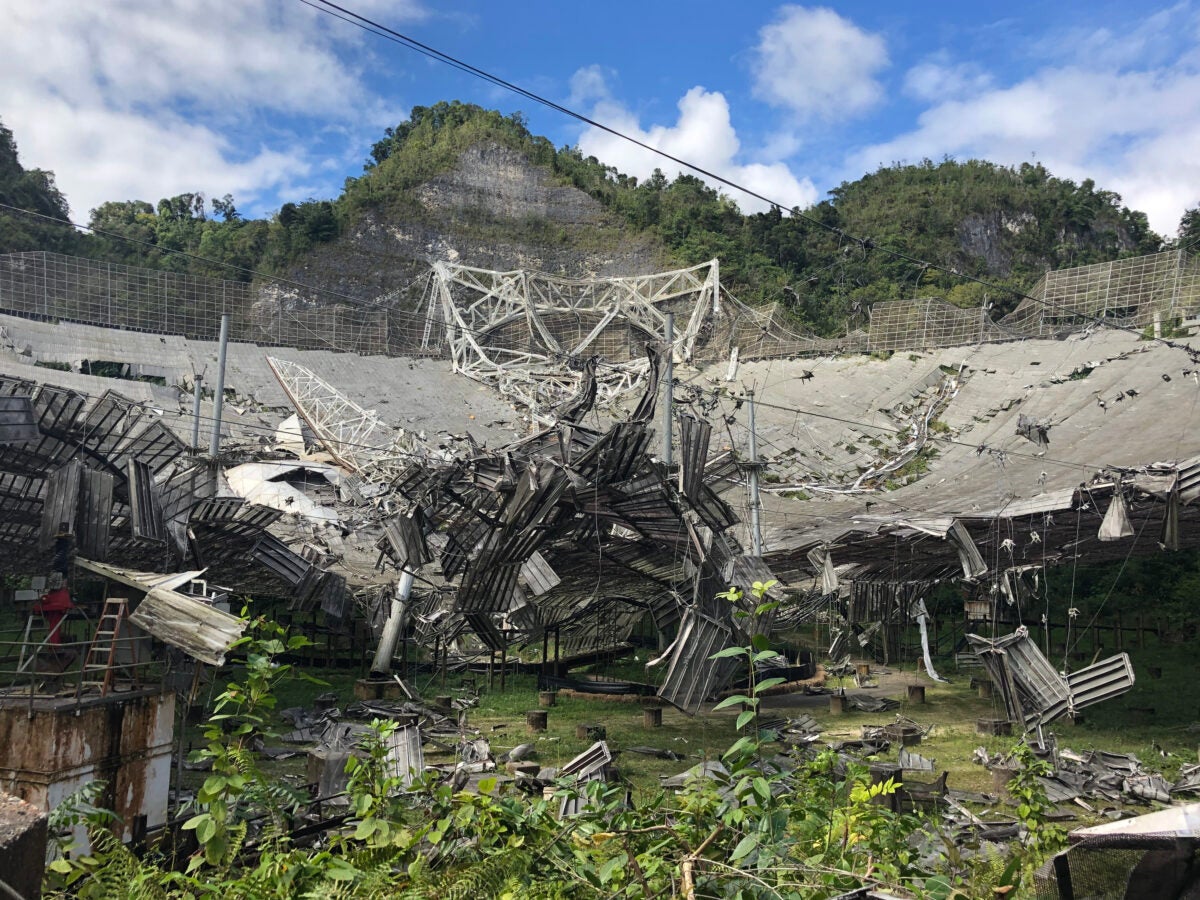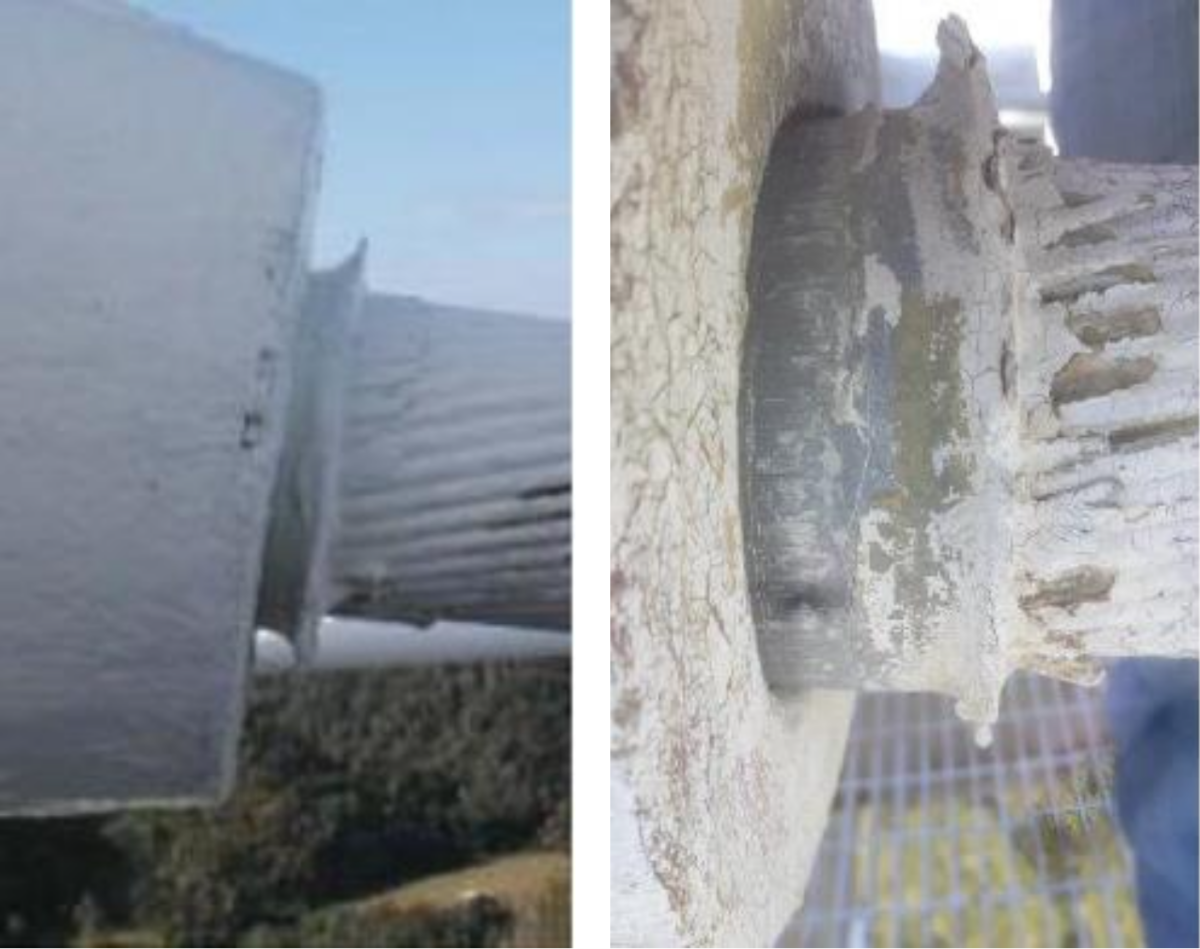
Arecibo Observatory’s main platform crashed into the dish below on Dec. 1, 2020. Credit: Michelle Negron, National Science Foundation
Puerto Rico’s Arecibo Observatory was felled by the combination of a hurricane, an equipment failure never before seen in the annals of engineering, and an “alarming” lack of concern from engineers and inspectors when crucial support cables were seen slipping out of their sockets years before the main platform of the famed radio telescope came crashing down in 2020, says a report released Oct. 25 by the National Academies of Sciences, Engineering, and Medicine (NASEM).
The publication is the most comprehensive analysis yet of the downfall of the fabled observatory, which occurred over several months in late 2020 when multiple cables holding the telescope’s main platform above its 1,000-foot-wide (305 meters) dish failed.
The loss of Arecibo was a devastating blow to astronomers, especially those in Puerto Rico. But it was also, from an engineering standpoint, “one of the most … baffling failures of the modern era,” the report says. And while the damage from the winds of Hurricane Maria in 2017 triggered the sequence of events that led to the collapse, the sockets may also have been weakened by current induced by Arecibo’s powerful radio transmitter, the report proposes.
The report also finds that the cables that eventually failed were seen slipping out of their sockets in 2018 and 2019, but that contracted consultants did not think they were a threat. The slippages were also not taken into account in post-Maria assessments of the structural integrity of the facility.
An anomaly of the type observed at the Arecibo sockets ”should raise all kinds of alarm,” says committee member Habib Tabatabai, an expert in structural cables at the University of Wisconsin-Milwaukee. Tabatabai tells Astronomy: “I give this analogy: A patient goes to a doctor and he has his eyes bulged out by 1 inch. The doctor looks at it and he has not seen anything like this before, and he consults his medical books and there’s no mention of this in their books. So this anomaly should not mean that it is OK.”
Missed signals
The first cable failure leading up to the collapse occurred Aug. 10, 2020. This cable was an auxiliary cable supporting the telescope’s platform and at the time, observatory officials were optimistic it could be repaired. However, this was followed by a main cable failure on Nov. 6, 2020. This led the telescope’s owner, the National Science Foundation (NSF), to conclude the telescope could no longer be safely repaired and needed to be decommissioned. But before that work could begin, another auxiliary cable gave way, immediately causing the 900-ton receiving platform to crash into the dish below on Dec. 1, 2020.
The cables were held in place by spelter sockets, a common type of cable socket that can be welded shut by filling it with molten zinc and letting it harden. But according to the report, these sockets began to fail after category-4 Hurricane Maria battered the observatory in 2017 with winds of up to 118 mph (190 km/h). “Gradually the zinc lost its hold on the cables and allowed several of them to pull out,” the report says.
“Absent Maria, the committee believes the telescope would still be standing today but might have eventually collapsed if its unique, accelerated zinc creep had not been addressed before it was decommissioned,” the report says.
There were also missed warning signs, the report says. In 2019, Arecibo staff recorded that key cables had begun to slip out of their sockets by as much as 1.5 inches. But neither staff nor contracted structural engineers appeared to recognize the threat this posed to the entire structure.
The slippage “should have raised the highest alarm level, requiring urgent action,” the report states. “The lack of documented concern from the contracted engineers about the inconsequentiality of cable pullouts or the safety factors between Hurricane Maria in 2017 and the failure is alarming.”
Had the cable slippage been identified as an issue well before the first cable failed, it would have been safe to access the top of the towers to install devices to relieve the load on the sockets, says Habatabai.

Misdirected repairs
The NSF told the NASEM committee that the socket slippage was never brought to the agency’s attention as an issue to be considered for further inspection, analysis, or repairs.
According to the report, Ray Lugo, who headed the Florida Space Institute at the University of Central Florida in Orlando — the observatory’s operator at the time of the collapse — told the committee, “I have used wire ropes and socketed cables lifting devices, and in my experience as an engineer, I’d never seen a cable, a socketed cable, with that amount of pull-through.” But, he added, “I was told that it had been reviewed by an external engineer, and that there was not any real concern about cable failure.”
The report does not identify the external engineer.
In the aftermath of Hurricane Maria, planned repairs for the telescope ran into bureaucratic hold-ups, and funding was delayed. But because inspectors had failed to identify the cable slippage as the most pressing issue, “none of the proposed repairs would have saved the Arecibo Telescope from collapse,” the report concludes. Instead, the repairs focused on one of the telescope’s remaining main cables, which ultimately never failed.
The engineering firm WSP was to oversee the repairs and perform structural analysis. Per the NASEM report, NSF representatives told the committee in 2022 that “NSF was informed that the WSP structural engineers visited the site in February 2020 to work on the spliced main cable replacement, and they performed inspection of the towers, cables, and platform primary structural elements while there, but no additional damage was noted during those inspections.”
NSF further said that it does not have any evidence that WSP looked specifically at socket pullouts.
The report states that the committee “was not afforded an opportunity to question WSP.” Habatabai says the committee was unable to coordinate a discussion because WSP was no longer under contract to the Arecibo Observatory.
As of publication, WSP had not responded to a request for comment.
Unprecedented behavior
The collapse is the first documented case of zinc creep resulting in cables pulling out of such sockets in over a century of use, the report says. The committee says they do not know and cannot prove what caused Arecibo’s extraordinary rate of zinc creep. But the committee did rule out some obvious candidates, like steel fatigue or corrosion caused by the humid climate and salty sea air, finding no evidence that they contributed to the collapse. Preventative measures that Arecibo took to maintain the sockets were effective in those regards, the report says.
The only plausible hypothesis the committee could think of is that the electromagnetic radiation from Arecibo’s radio transmitter — for decades the most powerful on Earth — may have accelerated the failure. When subjected to electric current, metals and ceramics can deform, a phenomenon called electroplasticity. This is used in certain manufacturing processes where high levels of current are applied to zinc, says Habatabai. In Arecibo’s case, the levels of current induced at the sockets would have been orders of magnitude lower. But over decades of use, the zinc that secured the cables may have deformed, allowing the cables to slip.
In other words, every radio signal Arecibo ever sent — every radar beam it bounced off of Mercury or Venus or near-Earth asteroids, and even the famous interstellar radio message it sent to the globular cluster M13 in an attempt to communicate with intelligent alien life — may have cumulatively contributed to the telescope’s eventual demise.
Habatabai says the unique nature of the failure means it’s important for engineers to learn from the collapse. Habatabai leads the Structural Engineering Lab at UW-Milwaukee and plans to begin small-scale experiments to verify the process. If experiments can show that low levels of current can accelerate zinc creep, it would not only improve understanding of the limitations of the material, but “it opens up opportunities for exploiting it for beneficial uses as well, potentially.”
RELATED: The rise and fall of Arecibo Observatory – an oral history

